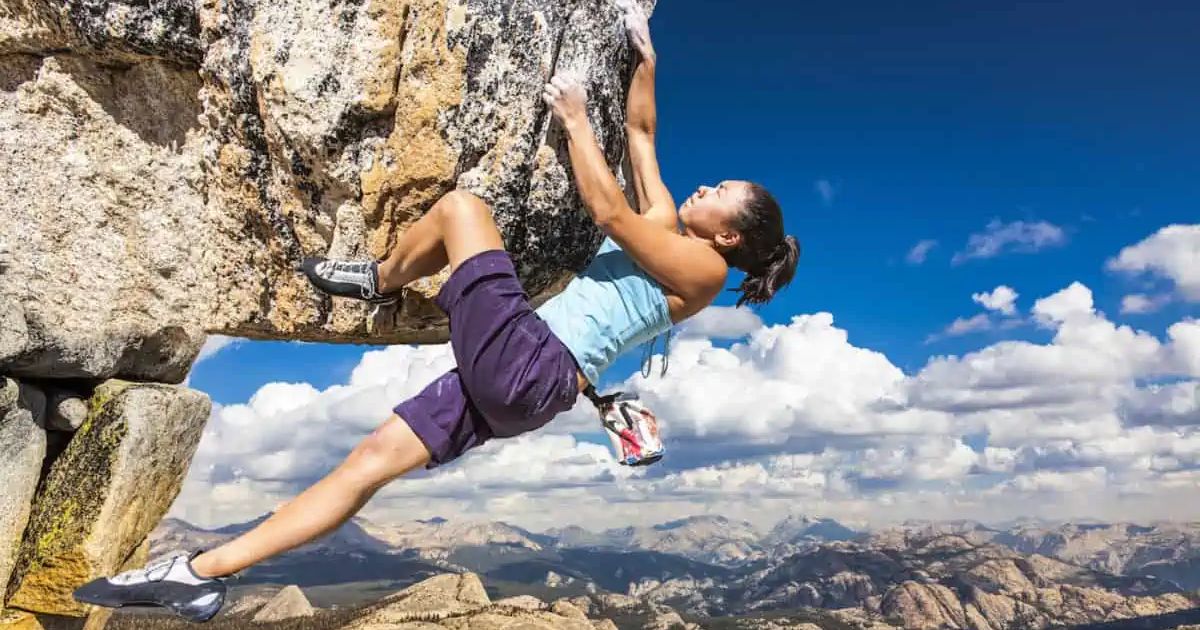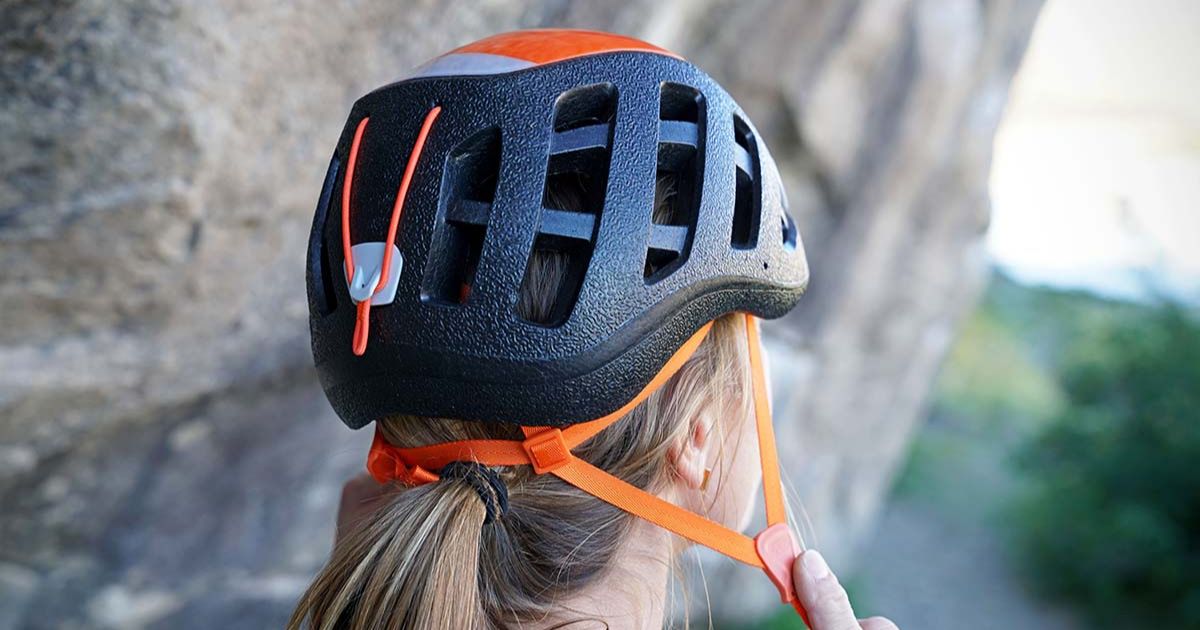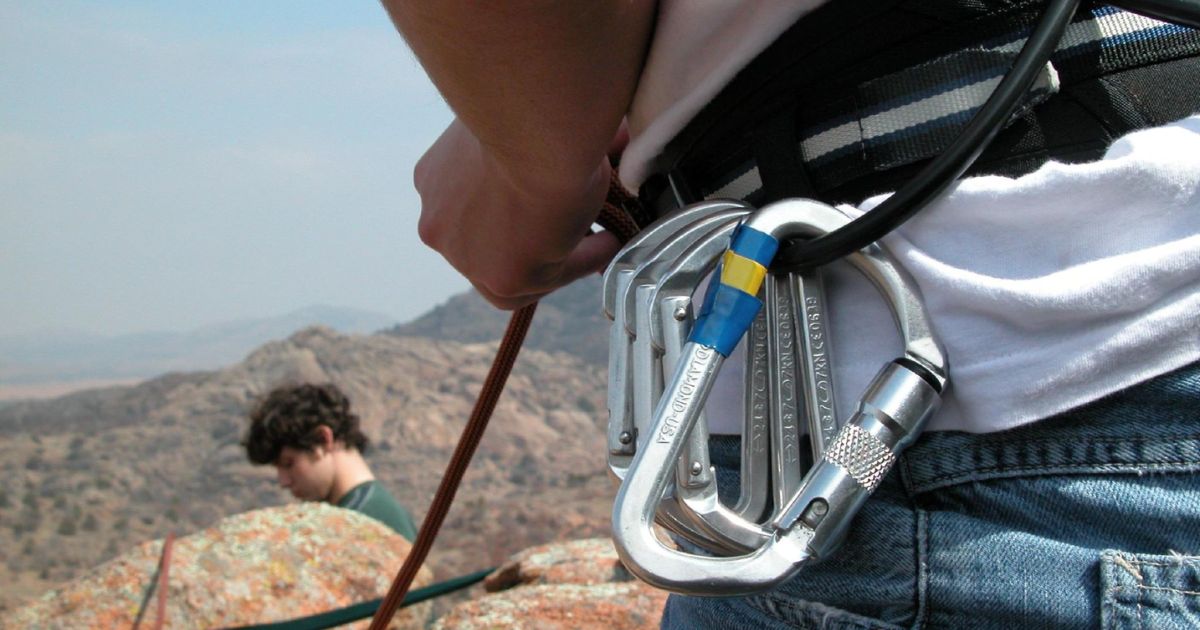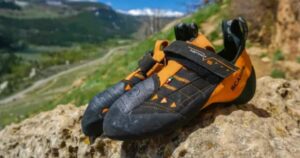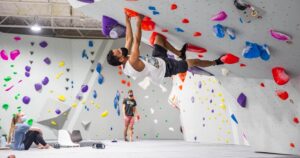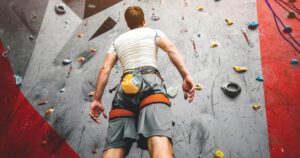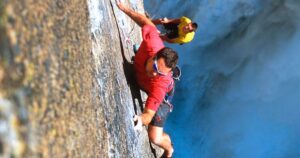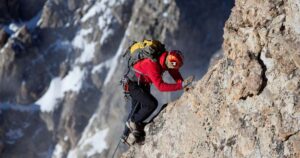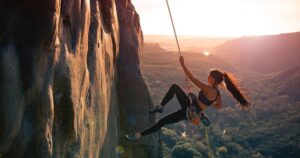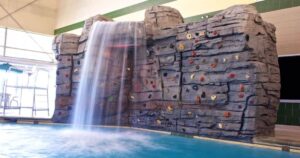Get ready to conquer the vertical world with confidence and style. Just as a knight dons his armor before battle, a rock climber must wear the right gear to ascend the heights. This comprehensive guide will equip you with the knowledge to choose the perfect attire for your climbing adventures. From the essential climbing helmet and harness to the moisture-wicking clothing that keeps you comfortable, we’ve got you covered. Prepare to join a community that embraces adventure and camaraderie as you step into the world of rock climbing fashion.
Key Takeaways
- A climbing helmet is essential for minimizing head injuries.
- Climbing shoes with good grip are crucial for balance and stability.
- Moisture-wicking clothing helps maintain comfort and performance during climbs.
- Having the right accessories and additional gear enhances the climbing experience and ensures a safe and enjoyable ascent.
Climbing Helmet
A climbing helmet is an essential piece of protective gear that should be worn when rock climbing hard to minimize the risk of head injuries. Whether you are a beginner or an experienced climber, head protection is crucial to ensure your safety while scaling rocks and cliffs. A climbing helmet serves as a barrier between your head and potential falling rocks or impacts from accidental falls. It is designed to absorb and distribute the force of an impact, reducing the risk of skull fractures, concussions, or other severe head injuries.
Modern climbing helmets are made with lightweight materials such as polycarbonate or ABS plastic, offering a comfortable fit without compromising protection. They typically feature adjustable chin straps and ventilation systems to ensure a secure and breathable experience. When choosing a climbing helmet, it is important to select one that fits properly and meets the safety standards set by relevant organizations, such as the UIAA or CE. Remember, investing in a high-quality climbing helmet is a small price to pay for the peace of mind and protection it provides.
Harness
When it comes to choosing a harness for rock climbing, there are two key factors to consider: comfort and functionality. While a comfortable harness can make a long day of climbing more enjoyable, it is crucial to prioritize functionality and safety. A well-designed harness should provide a secure fit, distribute weight evenly, and have strong attachment points for ropes and gear.
Comfort Vs. Functionality
For optimal performance and safety, selecting a rock climbing harness that balances comfort and functionality is crucial. When it comes to choosing a harness, climbers often face the dilemma of whether to prioritize comfort or style. Here are two key considerations to help you make an informed decision:
- Comfort:
- Padding: Look for a harness with sufficient padding in the waistbelt and leg loops to provide comfort during long climbs.
- Adjustable Fit: Opt for a harness with adjustable straps to ensure a personalized fit that maximizes comfort and minimizes pressure points.
- Functionality:
- Gear Loops: Consider the number and placement of gear loops on the harness, as this will impact your ability to carry and access equipment efficiently.
- Mobility: Look for a harness that allows for a wide range of movement, enabling you to climb with ease and confidence.
Balancing comfort and functionality is essential to enhance your climbing experience. Now, let’s delve into the next section on safety considerations.
Safety Considerations
To ensure a secure and reliable climbing experience, it is imperative to prioritize safety when selecting a harness. The fit of the harness is crucial, as it determines how well it will perform in case of a fall. A properly fitting harness should be snug but not overly tight, allowing for freedom of movement while still providing adequate support.
It is recommended to try on different harnesses and adjust the straps to find the perfect fit for your body type. Additionally, considering the sizing of your climbing shoes is essential when choosing a harness. Climbing shoes tend to have a snug fit, and it is important to ensure that the harness accommodates the extra bulkiness of the shoes without compromising comfort or safety. Remember, investing in a high-quality harness that fits well is a small price to pay for the peace of mind it brings during your climbing adventures.
Climbing Shoes
When it comes to rock climbing, having the right pair of climbing shoes is crucial for a successful and safe experience. There are three key points to consider when choosing climbing shoes: grip, comfort, and fit. The grip of the shoes ensures stability on the rock surface, while comfort and fit are vital for overall performance and preventing foot pain or injuries.
Shoe Grip Importance
- The grip of climbing shoes is a crucial factor for rock climbers. Having a good grip on the rock surface is essential for maintaining balance and stability while climbing. Here are some important points to consider regarding shoe grip maintenance and choosing the right climbing shoes:
- Shoe grip maintenance:
- Regularly clean the soles of your climbing shoes to remove dirt and debris that can affect the grip.
- Avoid walking on abrasive surfaces or using your climbing shoes for daily activities to prevent excessive wear and tear.
- Choosing the right climbing shoes:
- Look for shoes with sticky rubber soles, as they provide better traction on different types of rock surfaces.
- Consider the type of climbing you’ll be doing (e.g., bouldering, sport climbing, trad climbing) and choose shoes that are specifically designed for that style.
Comfort and Fit
Shoe comfort and fit play a significant role in enhancing a rock climber’s performance and ensuring stability while navigating challenging terrains. When it comes to climbing shoes, it is crucial to prioritize comfort without compromising on functionality. A well-fitting climbing shoe should feel snug but not overly tight, allowing for precise footwork and maximum control. To optimize comfort, look for climbing shoes made from moisture-wicking fabric that helps keep your feet dry by drawing sweat away from the skin.
This feature is essential for climbers as it prevents discomfort and blisters caused by excessive moisture. Additionally, some climbing shoes incorporate advanced technology for body temperature control, ensuring your feet stay comfortable and at an optimal temperature throughout your climbing session. Remember, a comfortable and well-fitted climbing shoe can greatly enhance your climbing experience.
Chalk Bag
The chalk bag is an essential accessory for rock climbers, providing a convenient and accessible way to keep hands dry and enhance grip on the climbing holds. While traditional chalk is commonly used, climbers now have alternatives such as liquid chalk and eco-friendly options like chalk balls. These alternatives offer the same benefits of dry hands and improved friction, but with less mess and environmental impact.
When it comes to chalk bag designs, there are numerous options available to suit individual preferences. Some chalk bags are simple and functional, with a drawstring closure and a brush holder for cleaning holds. Others feature additional pockets for storing small items like keys or a phone. Some climbers prefer larger chalk bags for extended climbing sessions, while others opt for smaller, lightweight bags for bouldering or sport climbing. Ultimately, the design of the chalk bag should provide easy access to chalk while being comfortable to wear during climbs.
Moisture-Wicking Clothing
Moisture-wicking clothing is essential for rock climbers to maintain comfort and performance during their climbs. When engaging in this physically demanding activity, climbers often work up a sweat. Moisture-wicking clothing helps to draw sweat away from the body, allowing it to evaporate quickly and keeping the climber dry. This not only enhances comfort but also prevents the build-up of moisture that can lead to chafing and discomfort.
One of the key benefits of moisture-wicking clothing is its ability to regulate body temperature. By pulling moisture away from the skin, these garments help to keep the climber cool in hot weather and warm in cold weather. Additionally, moisture-wicking clothing is typically made from synthetic materials such as polyester or nylon. These materials are lightweight, breathable, and quick-drying, making them ideal for rock climbing.
The table below provides a comparison of different moisture-wicking materials commonly used in rock climbing clothing:
| Material | Benefits |
|---|---|
| Polyester | Lightweight, breathable, quick-drying |
| Nylon | Durable, moisture-resistant, quick-drying |
| Merino wool | Natural fibers, odor-resistant, regulates body temperature |
| Polypropylene | Insulating, quick-drying, retains warmth when wet |
| Spandex | Stretchy, allows for freedom of movement |
Layering Options
Layering is an essential consideration for rock climbers to ensure optimal comfort and adaptability in varying weather conditions. When it comes to layering options, rock climbers have a range of choices to suit their needs. Here are some key base layer options and outerwear choices to consider:
Base layer options:
- Synthetic materials: These are great for moisture-wicking and quick-drying properties, keeping you dry and comfortable during intense climbs.
- Merino wool: Known for its natural temperature regulation and odor-resistant properties, merino wool base layers are a popular choice among climbers.
Outerwear choices:
- Softshell jackets: These provide excellent breathability and flexibility, making them suitable for mild to moderate weather conditions.
- Hardshell jackets: Designed to offer superior protection against wind and rain, hardshell jackets are ideal for harsher weather conditions.
Accessories and Additional Gear
When considering what to wear when rock climbing, it is important to also address the essential accessories and additional gear needed for a successful climb. One crucial accessory is climbing gloves. These gloves provide protection and grip, allowing climbers to maintain a firm hold on rocks and prevent injury. They are typically made of durable materials such as leather or synthetic materials with reinforced palms. When it comes to additional gear, one important item to have is a belay device.
Belay devices are used for controlling the rope during a climb, providing a means to catch a falling climber. There are various belay device options available, including tube-style devices and assisted braking devices. Each option has its advantages and it is important to choose one that suits your climbing style and preferences. Having the right accessories and additional gear can enhance your climbing experience and ensure a safe and enjoyable ascent.
Frequently Asked Questions
Are Climbing Helmets Required for All Types of Rock Climbing?
Climbing helmets are essential safety equipment for rock climbers as they protect against head injuries from falling rocks or accidental falls. While regulations vary, it is generally recommended to wear a climbing helmet for all types of rock climbing. Alternatives to helmets, such as beanies or hats, do not provide the same level of protection.
How Do I Properly Fit a Climbing Harness?
When fitting a climbing harness, proper technique is crucial to ensure safety and comfort. Avoid common mistakes such as incorrect sizing, improper leg loops positioning, and insufficient tightening. A well-fitted harness enhances performance and minimizes risk during rock climbing.
Can I Wear Regular Sneakers or Running Shoes for Rock Climbing Instead of Climbing Shoes?
While regular sneakers or running shoes may provide some traction and support for rock climbing, they are not specifically designed for the sport. Climbing shoes offer specialized features such as sticky rubber soles and a snug fit, providing better grip and stability on the rock surface.
Are All Chalk Bags the Same or Are There Specific Features to Look For?
When considering chalk bags for rock climbing, it is important to understand that not all chalk bags are the same. There are specific features to look for, such as size, closure mechanism, attachment options, and additional pockets.
What Type of Moisture-Wicking Clothing Is Best for Rock Climbing in Hot or Humid Environments?
When rock climbing in hot or humid environments, it is important to wear moisture-wicking clothing. These fabrics help to wick away sweat from the body, keeping you dry and comfortable. Choose lightweight, breathable materials for optimal performance.
Conclusion
In conclusion, choosing the right clothing and gear is crucial for a successful and safe rock climbing experience. Climbing helmets, harnesses, and shoes are essential for protection and stability. A chalk bag helps maintain a firm grip on holds while moisture-wicking clothing keeps the body dry and comfortable. Layering options provide flexibility in different weather conditions, and additional accessories can enhance the climbing experience. Did you know that approximately 3.4 million people participate in rock climbing in the United States each year? It’s a popular and thrilling sport that continues to attract outdoor enthusiasts.
